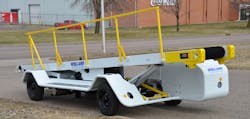Mobile Belt Loaders Meet Changing Needs of Ramp Operations
The standardized power platform of Wollard International’s TC-888 Mobile Belt Loader offers multiple power options, the ability to change out power packs quickly for maintenance and the versatility to choose another power option later on.
The TC-888 Mobile Belt Loader is available in zero-emission electric power, including lead acid battery and – for the first-time lithium battery with backwards compatibility to lead acid; as well as low emission Stage V and Tier 4 Final diesel power; and EPA-approved gasoline or LP fuel.
Wollard International’s best-selling product for more than 30 years, the TC-888 Mobile Belt Loader, will be at the International GSE Expo, Sept. 26-28 in Las Vegas, showcasing some of these design updates.
“With over 30 years of success selling the TC-888, the new updates will keep the TC-888 current with today’s customers’ needs. They also allow for options for the customers as their fleet makes changes from internal combustion engine to eGSE (electric ground support equipment), and from lead acid to lithium,” Wollard International director of sales and marketing Jerry Crump says.
“We are increasing the size of our battery compartment to allow for more battery options and updating our controllers to replace relay logic circuits for our eGSE offering to allow for a lithium-designed option – not a lead acid version retrofit with lithium.”
Other updates, according to Crump, include a new digital display for operators and an optional axle design to allow for disc brakes.
The TC-888 was designed to serve aviation markets domestically and globally, wherever there is a need to move baggage, cargo or parcels into a non-containerized aircraft hold. Customers include airlines, ground handlers, fixed-base operators, cargo handlers and government/military.
“With non-containerized cargo and bags, you would be surprised how much weight can add up,” Crump says. “Most bags that go in the belly of an aircraft can weigh up to 50-70 pounds each before incurring additional charges. They are, however, limited at 100 pounds by some carriers. If you are also moving parcels or mail, these packages can also be sizeable – in some special instances weighing a couple hundred pounds.”
At full incline, the conveyor capacity of the mobile belt loader is 2,000 pounds. The conveyor is 297.5 inches long and 31.5 inches wide. The conveyor moves bags and cargo at speeds ranging from 40 to 120 feet per minute. The vehicle itself is the same length as the conveyor but is 82 inches wide. Maximum vehicle speed is 25 mph.
Wollard engineers have reinforced the TC-888’s design to handle the challenging ramp environment.
“With a single-welded frame, the TC-888 is much more robustly built than some of its competitors, allowing for it to take the wear and tear of the ramp environment much better than other models on the market,” Crump says.
At 47.5 inches high, the TC-888 maneuvers easily around the ramp, due to the high visibility for situational awareness and safety, Crump says. The belt loader services aircraft with doorsills ranging in height from 42 to 167 inches.
Due to its simplicity in design and not having bolt-on skirts and panels, Crump says the TC-888 does not show the wear and tear as some other belt loader models do.
The original TC-888, inspired by lessons learned from the previous model (TC-886), has a tubular, wrap-around steel bumper that absorbs and deflects impacts and protects the belt loader and other ramp equipment, whereas the TC-886 had a square, flat plate design.
“By not having a squared-up surface on our chassis, it allows impacts to be absorbed/deflected, and we see much less damage to the chassis than our competitors. This increases uptime on the equipment and leads to lower total cost of ownership,” Crump says.
Crump also points to simplified hydraulic servicing points, electrical panels and improved maintenance-free wet brakes as features that improve vehicle uptime.
Diagnostics are available through the use of a J1939 CAN bus port. LED warning indicators give warnings for the alternator, engine oil pressure, coolant temperature and brakes.
Similar to most GSE, the TC-888 started as a petroleum-powered piece of equipment. With the adaptation of eGSE, the first electric version of the TC-888 had a smaller lead acid battery to fit the common power pack at that time.
Today, Wollard still sells primarily EPA/CARB-certified internal combustion belt loaders, but Crump says company officials are seeing more and more interest in both lead acid and lithium batteries being quoted.
“With more customers making the move to sustainable ramp equipment, I don’t believe it will be long before the TC-888e will be our primary version for certain markets,” he says.
When customers opt for electric, whether they choose lead acid or lithium depends on the customer and their fleet plan. Crump says some customers are adopting lithium on a broad basis, others are using it for only certain eGSE or evaluating if lithium makes sense for them.
“This is why, as a manufacturer, we design in the ability to support our customers no matter what step of the lithium versus lead acid debate they are in,” he says.
Since all the TC-888 power packages offer the same functionality, Crump says the decision comes down to the infrastructure available to support a specific power package.
“These TC-888 & 886 have had many different configurations over the 30 years, and each kit will be designed for that specific build,” Crump says.
The TC-888 offers additional options beyond power packages.
“We have different lift assemblies, lights, seats, operator cab and many more,” Crump explains. “All of this allows us to deliver to customers around the globe the belt loader that fits their needs.”
For those with ground support operations in cold climates, Crump notes customers might want to add a winterization package or a full cab with heat to keep users warm while operating the equipment.
Numerous models from years past are still operating on the ramp, a testament to the durability of Wollard’s equipment.
That alone is great feedback, according to Crump.
“Ramp operations are not static, and as they change, we continue to change to meet the new operational demands,” he concludes.
About the Author
Rebecca Kanable
Assistant Editor
Rebecca Kanable, a veteran journalist, worked with Endeavor Business Media's aviation group from 2021 to 2024 as assistant editor of Airport Business, AMT and Ground Support Worldwide. She previously worked for various publications, including trade magazines and newspapers.

